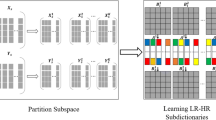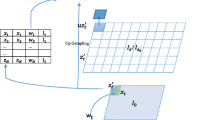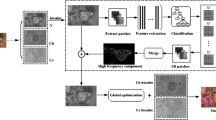Abstract
We explore in this paper an efficient algorithmic solution to single image super-resolution (SR). We propose the gCLSR, namely graph-Constrained Least Squares Regression, to super-resolve a high-resolution (HR) image from a single low-resolution (LR) observation. The basic idea of gCLSR is to learn a projection matrix mapping the LR image patch to the HR image patch space while preserving the intrinsic geometric structure of the original HR image patch manifold. Even if gCLSR resembles other manifold learning-based SR methods in preserving the local geometric structure of HR and LR image patch manifolds, the innovation of gCLSR lies in that it preserves the intrinsic geometric structure of the original HR image patch manifold rather than the LR image patch manifold, which may be contaminated by image degeneration (e.g., blurring, down-sampling and noise). Upon acquiring the projection matrix, the target HR image can be simply super-resolved from a single LR image without the need of HR-LR training pairs, which favors resource-limited applications. Experiments on images from the public database show that gCLSR method can achieve competitive quality as state-of-the-art methods, while gCLSR is much more efficient in computation than some state-of-the-art methods.









Similar content being viewed by others
Explore related subjects
Discover the latest articles and news from researchers in related subjects, suggested using machine learning.References
Baker S, Kanade T (2002) Limits on super resolution and how to break them. IEEE Transactions on Pattern Analysis and Machine Intelligence 24(9):1167–1182
Belkin M (2003) Problems of learning on manifolds. PhD thesis, University of Chicago
Belkin M, Niyogi P (2001) Laplacian eigenmaps and spectral techniques for embedding and clustering. Advances in Neural Information Processing Systems 14:585–591
Bevilacqua M, Roumy A, Guillemot C, Alberi Morel M-L (2012) Neighbor embedding based single image super-resolution using semi-nonnegative matrix factorization, In: IEEE International Conference on Acoustics and Signal Processing, pp. 1289–1292
Bevilacqua M, Roumy A, Guillemot C, Alberi-Morel A (2012) Low-complexity single-image super-resolution based on nonnegative neighbor embedding, In: British Machine Vision Conference, BMVC
Chan T-M, Zhang J, Pu J, Huang H (2009) Neighbor embedding based super-resolution algorithm through edge detection and feature selection. Pattern Recognit Lett 30:494–502
Chang H, Yeung D, Xiong Y (2004) Super-resolution through neighbor embedding, In: IEEE International Conference on Computer Vision and Pattern Recognition (CVPR), pp. 275–282
Chopra A, Lian H (2010) Total variation, adaptive total variation and nonconvex smoothly clipped absolute deviation penalty for denoising blocky images. Pattern Recognition 43:2609–2619
Chung FRK (1997) Spectral graph theory, volume 92 of regional conference series in mathematics. AMS 15(12):3736–3745
Daniel D, Lee H (1999) Sebastian Seung, learning the parts of objects by non-negative matrix factorization. Nature 401(6755):788–791
Ding C, Li T, Jordan MI (2010) Convex and semi-nonnegative matrix factorizations. IEEE Transactions on Pattern Analysis and Machine Intelligence 32(1):45–55
Elad M, Aharon M (2006) Image denoising via sparse and redundant representations over learned dictionaries. IEEE Transactions on Image Processing 54(12):3736–3745
Fan W, Yeung DY (2007) Image hallucination using neighbor embedding over visual primitive mainfolds, In: IEEE International Conference on Computer Vision and Pattern Recognition (CVPR), pp. 1–7
Farsiu S, Elad M, Milanfar P (2006) Multiframe demosaicing and super-resolution of color images. IEEE Transactions on Image Processing 15(1):141–159
Freeman W, Pasztor E, Carmichael O (2000) Learning low-level vision. Int J Comput Vis 40(1):25–47
Gao X, Zhang K, Tao D, Li X (2011) Joint learning for single image super-resolution via coupled constraint. IEEE Transactions on Image Processing 21(2):469–480
Lawson and Hanson (1974) Solving least squares problems, Prentice-Hall
Lin Z, Shum H (2004) Fundamental limits of reconstruction-based superresolution algorithms under local translation. IEEE Transactions on Pattern Analysis and Machine Intelligence 26(1):83–97
Milanfar P (2010) Super-resolution imaging. CRC Press
Park SC, Park MK, Kang MG (2003) Super-resolution image reconstruction: a technical overview. IEEE Signal Process Mag 20(3):21–36
Rudin L, Osher S, Fatemi E (1992) Nonlinear total variation based noise removal algorithms. Phys D: Nonlinear Phenomena 60(1–4):259–268
Su, Tian Q, Sebe N, Ma J (2005) Neighborhood issue in single-frame image super-resolution, In: IEEE International Conference on Multimedia and Expo (ICME)
Tikhonov N, Arsenin VY (1977) Solutions of ill-posed problems. Winston, New York
Tsai RY, Huang TS (1984) Multiple frame image restoration and registration. In: Advances in computer vision and image processing. JAI, Greenwich, pp 317–339
van Ouwerkerk JD (2006) Image super-resolution survey. Image and Vision Computing 24:1039–1052
Wang Z, Bovik AC, Sheikh HR, Simoncelli EP (2004) Image quality assessment: from error measurement to structural similarity. IEEE Transactions on Image Processing 13(4):600–612
Yang J, Wright J, Huang T, Ma Y (2008) Image super-resolution as sparse representation of raw image patches, In: IEEE International Conference on Computer Vision and Pattern Recognition (CVPR), pp. 1–8
Yang J, Wright J, Huang T, Ma Y (2010) Image super-resolution via sparse representation. IEEE Transactions on Image Processing 19(11):2861–2873
Zhang K, Gao X, Li X, Tao D (2011) Partially supervised neighbor embedding for example-based image super-resolution. IEEE Journal of Selected Topic in Signal Processing 5(2):230–239
Zibetti MVW, Bazán FSV, Mayer J (2011) Estimation of the parameters in regularized simultaneous super-resolution. Pattern Recognit Lett 32:69–78
Acknowledgment
The research was supported by the major national science and technology special projects (2010ZX03004-003-03, 2010ZX03004-001-03), the National Basic Research Program of China (973 Program) (2009CB320906), the National Natural Science Foundation of China (61231015, 61172173, 61003184, 61070080, 61170023).
Author information
Authors and Affiliations
Corresponding author
Rights and permissions
About this article
Cite this article
Jiang, J., Hu, R., Han, Z. et al. Efficient single image super-resolution via graph-constrained least squares regression. Multimed Tools Appl 72, 2573–2596 (2014). https://doi.org/10.1007/s11042-013-1567-9
Published:
Issue Date:
DOI: https://doi.org/10.1007/s11042-013-1567-9




